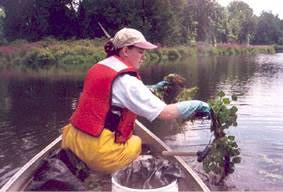
There is an emerging threat to the Connecticut River and the waters within its basin that any boater, paddler, angler or property manager can help control. European water chestnut (Trapa natans) is an aquatic invasive plant that spreads rapidly, covering bodies of water with dense foliage impeding recreational activities such as boating, fishing, and swimming.
The Connecticut River Conservancy (CRC), formerly Connecticut River Watershed Council, is hosting a variety of opportunities this summer for residents to learn more and help remove this threat.
Quick and thorough action must be taken to prevent this plant from taking over because water chestnut reproduces exponentially. “The good news is that this plant is easy to identify, it reproduces only by seed, and pulls up easily,” notes Alicea Charamut, River Steward for the Connecticut River Conservancy.
She continues, “It can be managed by trained volunteers. For small to moderate infestations, no chemicals or equipment are needed other than willing volunteers in canoes, kayaks, and shallow draft boats. This work offers an opportunity for those of us who love our rivers, lakes and ponds to give back to them in a fun and easy way.”
 There are two opportunities to learn to identify and report the plants. CRC hosted an information session at the Connecticut River Museum in Essex on Tuesday, June 13, and will do so again at LL Bean at Evergreen Walk in South Windsor on Friday, June 19. Both events are at 6:30 p.m. There will be a brief presentation, live plants on display, and plenty of time for questions.
There are two opportunities to learn to identify and report the plants. CRC hosted an information session at the Connecticut River Museum in Essex on Tuesday, June 13, and will do so again at LL Bean at Evergreen Walk in South Windsor on Friday, June 19. Both events are at 6:30 p.m. There will be a brief presentation, live plants on display, and plenty of time for questions.
Charamut is also available to give talks to groups within the Connecticut River watershed, who want to bring this information to their organization or club.
Paddlers and boaters can also help CRC manage known infestations. Five hand-pulling events are already scheduled for the floating meadows of the Mattabesset River in Middletown and Keeney Cove in Glastonbury in June and July with more to be scheduled as new infestations are reported. The work is fairly easy, a little dirty and very rewarding. Supplies are provided. Those who wish to attend need only bring their boat and PFD.
In addition, CRC is coordinating a River Sweep of the Connecticut River, its coves and ponds to scout for this invasive plant. “Because the seeds from these plants can last for up to twelve years, knowing where these plants have been found is crucial. In order to effectively control the spread of these plants we must monitor locations where they have been found each year and have as many eyes on the water as possible.” Paddling and boating groups can adopt a section of the river to scout for plants on or around Saturday, June 24.
“It will take a community of those who care coming together to help control this plant,” says Charamut. The Connecticut River Conservancy joins many partners in the effort to control water chestnut in the Connecticut River watershed. The US Fish and Wildlife Service, the Connecticut Department of Energy and Environmental Protection, Lower Connecticut River Council of Governments, Jonah Center for Earth and Art, Connecticut River Museum, and the Connecticut Agricultural Experiment Station are all active participants working to help control this aquatic invasive plant.
More groups are encouraged to join the effort. Much of the work in the lower Connecticut River Valley here in Connecticut is possible thanks to a generous grant from the Rockfall Foundation.
For more information about education and volunteer opportunities to help control European water chestnut, visit www.ctriver.org/get-involved or contact Alicea Charamut at [email protected].